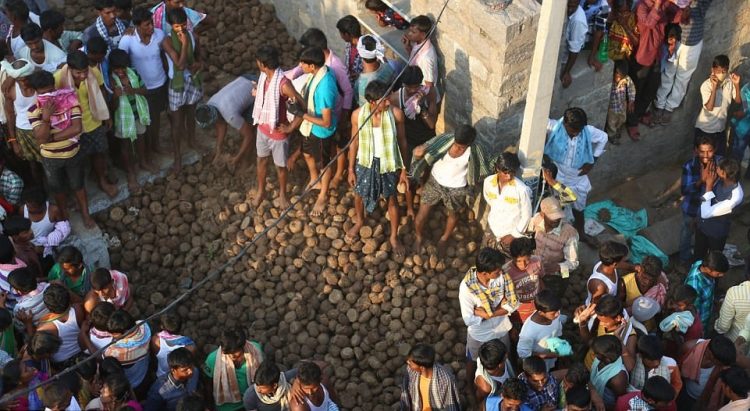Da Shuhua – The Art of Spraying Melted Iron to Create Fireworks

Known as ‘the poor man’s fireworks’, Dashuhua is a 500-year-old pyrotechnic ritual used in Nuanquan, China, to celebrate the Lunar New Year. The small town of Nuanquan, in northwestern China’s Hebei province, is home to one of the world’s most dangerous yet mesmerizing fireworks displays. Although fireworks have been a part of Chinese celebrations since […]
Traditional Stone-Pelting Battle Leaves 77 People Injured in Just 7 Minutes

Every year, hundreds of people from India’s Uttarakhand state engage in Bagwal, a brutal stone-pelting battle that often leaves dozens with severe injuries that require medical attention. Bagwal literally means “fight with stones”, so it’s a pretty fitting name for a celebration that’s all about hurling big stones at the opposing side. Four clans gather […]
Indian Village Ends Diwali With Massive Cow Dung Battle

The small Indian village of Gummatapura is famous all over the world for its unique way of ending the annual Diwali celebrations – a massive cow dung battle called “Gorehabba”. Spain has La Tomatina, a famous battle with tomatoes, Italy has the traditional Ivrea Battle of Oranges, and India has Gorehabba, a cow dung battle […]
Festival of Exploding Hammers Ushers in Lent with a Bang

Every February, on the day before Lent, the small Mexican town of San Juan de la Vega honors its namesake saint with a loud tradition that has come to be known as the Festival of Exploding Hammers. The origins of this bombastic festival are shrouded in mystery. According to one local story, Juan de la […]
The Annual Cow Dung Cake Battle of Kairuppala

Every year, the people of Kairuppala, a village in India’s Andhra Pradesh state, engage in an epic cow dung cake battle that often leaves dozens injured. They believe the tradition brings them good health and prosperity. Legend has it that Lord Veerabhadra Swamy, a fearsome form of the Hindu god Shiva, and the Goddess Bhadrakhali […]
Man Celebrates His Birthday for 46 Hours by Flying Back in Time
Time travel is technically possible, by just hopping on flights and traveling across time zones. A German man recently decided to take advantage of this fact to bag the Guinness Record for the world’s longest birthday. Of course, the longest birthday isn’t necessarily the most fun, given that he spent almost all of it sitting in a plane seat, […]
Lithuanians Build Intricate Straw Sculpture Park Only to Burn It Down in Fiery Celebration

Every year, the people of New Town, in Panevėžys, Lithuania, hold an annual festival where tall intricate sculptures made completely out of straws are displayed for the entire month of October in a temporary Straw Sculpture Park. At the end of the month, the straw sculptures are burned to the ground to mark the transition […]
Revelers Throw Dead Rats at Each Other as Part of Bizarre Spanish Festival

Having a dead rat thrown straight in the face might not be everyone’s idea of a good time, but for the people of El Puig, the yearly Battle of the Rats is an eagerly awaited event. During the bizarre celebration, people pick up frozen rat corpses and throw them at each other in the name […]
Gotmar Mela – India’s Centuries-Old Stone Pelting War

For over three hundred years, the residents of Pandhurna and Sawargaon, two Indian villages located on the banks of the river Jaam, have been engaging in a bizarre stone-pelting ritual called Gotmar Mela that leaves hundreds critically injured and even dead. The stone war of Gotmar Mela, as its sometimes referred to, takes place every […]
New Yorkers Celebrate “Good Riddance Day”

A giant paper shredder set up in Time Square was responsible with getting rid of all the bad bits of 2010. This Tuesday, on the fourth annual “Good Riddance Day” held by the Times Square Alliance, people had the chance to free themselves from all the unpleasant memories of 2010, by writing them down and […]
Noche de Rábanos – Spanish Festival Celebrating Radishes

Noche de Rabanos (Night of the Radishes) takes place every year, on the 23rd of December, in Oaxaca,Spain and is one of the most impressive vegetable festivals around the world. The radish was brought to the Americas in the 16th century, and back then the vendors used to carve them and use them on their […]
Cascamorras – The Dirty Festival of Granada

Every September 8th, the Spanish towns of Baza and Guadix host the Festival of Cascamorras, an event unique to the Granada region of Spain. According to legend, the origin of “La Fiesta del Cascamorras” can be traced back to 1490, when Don Luis de Acuña Herrera decided to built the Church of Mercy in the […]
Redheads Celebrate Red Head Day in Holland

Yesterday, thousands of redheads gathered in the Dutch city of Breda, for the fifth edition of the Red Head Festival. Participants were asked to come dressed in white, a color that really compliments their hair color, and were able to take part in all kinds of fun activities, workshops and even a fashion show. The […]
Panjat Pinang – A Slippery Tradition of Indonesia

Dating back to the Dutch colonial days, Panjat Pinang is one of the oldest, most popular traditions in Indonesia. Panjat Pinang is a very unique way of celebrating Indonesia’s Independence Day. Every year, in towns and villages around the country, tall nut-trees are chopped down and their trunks placed vertically, in the center of each […]
The Shocking Fireball Festival of Nejapa

The Fireball Festival is an old tradition celebrated each year, on August 31st, in the town of Nejapa, El Salvador. “Las Bolas de Fuego”, as the locals refer to this bizarre event, is actually a reenactment of the fight between San Jeronimo and the devil. In 1922, the people of Nejapa and the surrounding area […]
